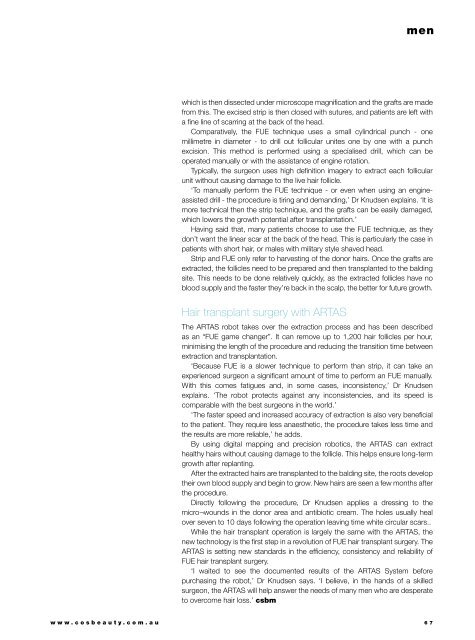Cosmetic Surgery and Beauty Magazine #67
Cosmetic Surgery and Beauty is the go-to magazine for anyone considering an aesthetic procedure. Covering a huge range of treatments with in-depth expert interviews and hundreds of before and after photos.
Cosmetic Surgery and Beauty is the go-to magazine for anyone considering an aesthetic procedure. Covering a huge range of treatments with in-depth expert interviews and hundreds of before and after photos.
Create successful ePaper yourself
Turn your PDF publications into a flip-book with our unique Google optimized e-Paper software.
men<br />
which is then dissected under microscope magnification <strong>and</strong> the grafts are made<br />
from this. The excised strip is then closed with sutures, <strong>and</strong> patients are left with<br />
a fine line of scarring at the back of the head.<br />
Comparatively, the FUE technique uses a small cylindrical punch - one<br />
millimetre in diameter - to drill out follicular unites one by one with a punch<br />
excision. This method is performed using a specialised drill, which can be<br />
operated manually or with the assistance of engine rotation.<br />
Typically, the surgeon uses high definition imagery to extract each follicular<br />
unit without causing damage to the live hair follicle.<br />
‘To manually perform the FUE technique - or even when using an engineassisted<br />
drill - the procedure is tiring <strong>and</strong> dem<strong>and</strong>ing,’ Dr Knudsen explains. ‘It is<br />
more technical then the strip technique, <strong>and</strong> the grafts can be easily damaged,<br />
which lowers the growth potential after transplantation.’<br />
Having said that, many patients choose to use the FUE technique, as they<br />
don’t want the linear scar at the back of the head. This is particularly the case in<br />
patients with short hair, or males with military style shaved head.<br />
Strip <strong>and</strong> FUE only refer to harvesting of the donor hairs. Once the grafts are<br />
extracted, the follicles need to be prepared <strong>and</strong> then transplanted to the balding<br />
site. This needs to be done relatively quickly, as the extracted follicles have no<br />
blood supply <strong>and</strong> the faster they’re back in the scalp, the better for future growth.<br />
Hair transplant surgery with ARTAS<br />
The ARTAS robot takes over the extraction process <strong>and</strong> has been described<br />
as an “FUE game changer”. It can remove up to 1,200 hair follicles per hour,<br />
minimising the length of the procedure <strong>and</strong> reducing the transition time between<br />
extraction <strong>and</strong> transplantation.<br />
‘Because FUE is a slower technique to perform than strip, it can take an<br />
experienced surgeon a significant amount of time to perform an FUE manually.<br />
With this comes fatigues <strong>and</strong>, in some cases, inconsistency,’ Dr Knudsen<br />
explains. ‘The robot protects against any inconsistencies, <strong>and</strong> its speed is<br />
comparable with the best surgeons in the world.’<br />
‘The faster speed <strong>and</strong> increased accuracy of extraction is also very beneficial<br />
to the patient. They require less anaesthetic, the procedure takes less time <strong>and</strong><br />
the results are more reliable,’ he adds.<br />
By using digital mapping <strong>and</strong> precision robotics, the ARTAS can extract<br />
healthy hairs without causing damage to the follicle. This helps ensure long-term<br />
growth after replanting.<br />
After the extracted hairs are transplanted to the balding site, the roots develop<br />
their own blood supply <strong>and</strong> begin to grow. New hairs are seen a few months after<br />
the procedure.<br />
Directly following the procedure, Dr Knudsen applies a dressing to the<br />
micro¬wounds in the donor area <strong>and</strong> antibiotic cream. The holes usually heal<br />
over seven to 10 days following the operation leaving time white circular scars..<br />
While the hair transplant operation is largely the same with the ARTAS, the<br />
new technology is the first step in a revolution of FUE hair transplant surgery. The<br />
ARTAS is setting new st<strong>and</strong>ards in the efficiency, consistency <strong>and</strong> reliability of<br />
FUE hair transplant surgery.<br />
‘I waited to see the documented results of the ARTAS System before<br />
purchasing the robot,’ Dr Knudsen says. ‘I believe, in the h<strong>and</strong>s of a skilled<br />
surgeon, the ARTAS will help answer the needs of many men who are desperate<br />
to overcome hair loss.’ csbm<br />
www.cosbeauty.com.au 67


















